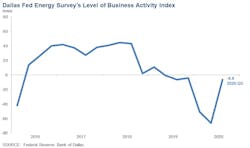Fed Dallas Energy Survey: contraction continues, but moderated
Activity in the oil and gas sector declined modestly in third-quarter 2020, according to oil and gas executives responding to the Dallas Fed Energy Survey. Data were collected on Sept. 9-17, and 166 energy firms responded. Of the respondents, 112 were exploration and production firms and 54 were oilfield services firms.
The business activity index—the survey’s broadest measure of conditions facing Eleventh District energy firms—remained in negative territory but improved from -66.1 in the second quarter to -6.6 in the third quarter, suggesting that the pace of the contraction has significantly lessened.
Production indexes rose significantly but remained negative, suggesting a moderation in production declines. According to exploration and production (E&P) executives, the oil production index rose from -62.6 in the second quarter to -15.4 in the third. The natural gas production index increased 38 points to -10.1.
The index for capital expenditures for E&P firms increased from -66.1 in the second quarter to -16.4 in the third, indicating a less-severe reduction in capital spending. This means that expenditures are declining but not as much as before. Additionally, the index for capital expenditures for oilfield services firms increased from -73.5 to -35.1.
Conditions among oilfield services firms continued to deteriorate, albeit at a slower rate. The equipment utilization index jumped 50 points to -18.9 in the third quarter, implying utilization declined but at a much slower pace than over the prior quarter. The operating margins index increased from -68.6 to -30.8. The index of prices received for services also remained in negative territory but moved up, from -64.7 to -26.4. Firms found some relief as the input costs continued to decline; the index was -9.5 this quarter.
Labor-related indicators fell again, but at a more modest pace than last quarter. The aggregate employment index posted a sixth consecutive negative reading but moved up from -46.1 to -18.1. Additionally, the index of aggregate employee hours worked increased from -47.0 to -15.3. The index for aggregate wages and benefits remained in negative territory but rose from -41.7 to -19.4.
The company outlook index returned to barely positive territory in the third quarter, coming in at 1.9. The near-zero reading indicates the outlook remained relatively unchanged, a stabilization from the sharp deterioration seen over the prior two quarters. Additionally, fewer firms noted rising uncertainty this quarter than last, and the aggregate uncertainty index fell 19 points to 17.2.
On average, respondents expect a West Texas Intermediate (WTI) oil price of $43.27/bbl by year-end 2020, with responses ranging from $30 to $60/bbl. Survey participants expect Henry Hub natural gas prices to be $2.55/MMbtu by yearend. For reference, WTI spot prices averaged $38.47/bbl during the survey collection period, and Henry Hub spot prices averaged $2.05/MMbtu.
